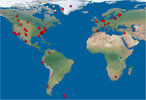Rhys
Jedi Master
I had a go at creating a map of what the Earth would have looked like just before the Younger Dryas event. It's pretty much based on the information in @Pierre's "Cometary Encounters" book.
I'd love for someone to weigh in and point out anything I have missed. The North Pole has been moved to the Hudson Bay region, I got rid of all the ice around Greenland and Antarctica, and dropped the sea level 65m.

I added a grid so you can see the old latitudes (placed at 10 degree increments). It's strange to see the U.K at the same latitude as Honduras, Scandinavia and the northern coast of Siberia!

I'd love for someone to weigh in and point out anything I have missed. The North Pole has been moved to the Hudson Bay region, I got rid of all the ice around Greenland and Antarctica, and dropped the sea level 65m.
I added a grid so you can see the old latitudes (placed at 10 degree increments). It's strange to see the U.K at the same latitude as Honduras, Scandinavia and the northern coast of Siberia!

 “Rebound of between 400-1000m” means, essentially, and old world map is anyone’s guess!
“Rebound of between 400-1000m” means, essentially, and old world map is anyone’s guess!

